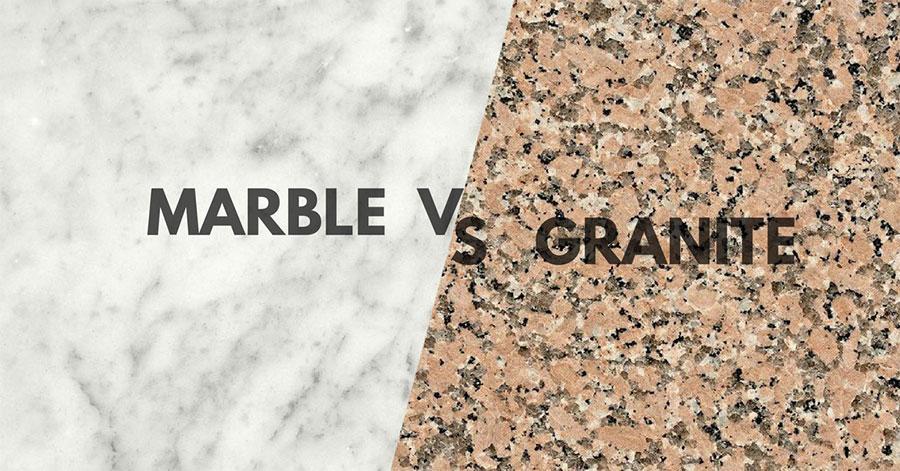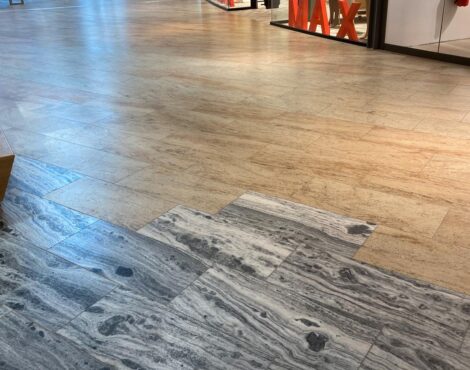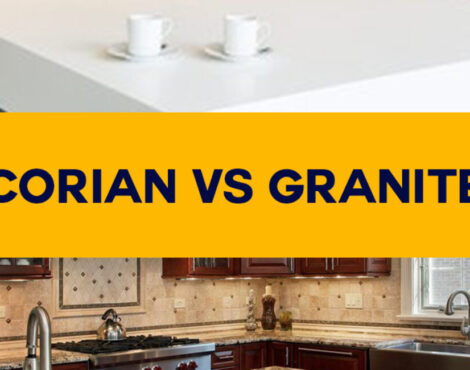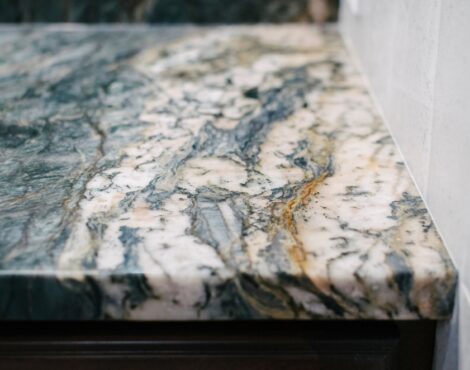Have you ever contemplated which natural stone would best suit your home or office? Perhaps you’ve contemplated the timeless appeal of granite or the luxurious elegance of marble. As two of the most popular options in the world of interior design, both granite and marble boast their unique characteristics, capable of elevating any space with a touch of sophistication. But how do you decide between these two captivating materials? In this comprehensive exploration, we’ll dive into the diverse aspects of granite Vs. marble. From their geological properties to pricing and finer details, we aim to equip you with the knowledge needed to make an informed choice for your project. So, let’s embark on this journey to discover the perfect natural stone for your space.
ALSO READ | Granite vs. Quartzite: Comparing Two Titans of the Natural Stone World
Granite Vs Marble Geology
One fundamental similarity between granite and marble is that they are both natural stones, originating from the Earth’s geological processes. Let’s talk about the geological origins of granite and marble.
Granite
Granite forms through the slow cooling and solidification of magma deep within the Earth’s crust, making it an igneous rock. This process, occurring over millions of years, results in the formation of large mineral crystals within the rock. Quartz, feldspar, and mica are the primary minerals found in granite, giving it its characteristic speckled appearance and varied colours, ranging from earthy tones to vibrant hues.
Marble
On the other hand, marble originates from the transformation of limestone or dolomite rock, undergoing metamorphism due to intense heat and pressure deep within the Earth’s crust. This process causes the original minerals to recrystallize and form marble. Calcite, the most common mineral in marble, gives it its distinctive veining patterns and smooth texture. Depending on the impurities present during its formation, marble can exhibit a wide range of colours, from pure white to deep black, with a spectrum of hues in between.
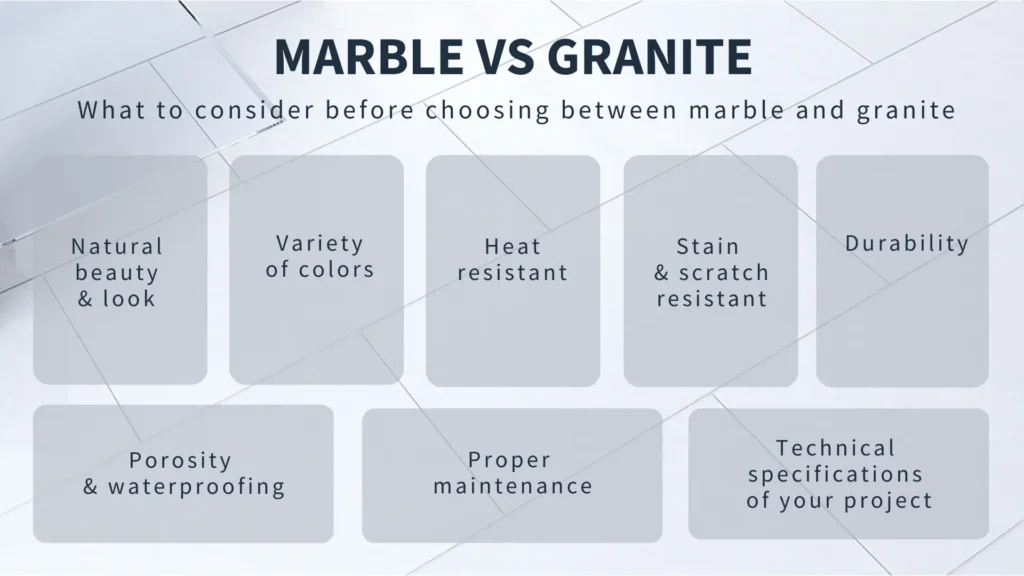
Difference Between Granite and Marble Aesthetics and Appearance
- Marble typically has a soft, delicate appearance with veining and a wide range of colours, including white, grey, black, pink, and green. The veining patterns are unique to each slab, adding a luxurious and classic appeal.
- Granite often has a speckled or mottled appearance due to the various minerals it contains. It comes in various colours, including white, grey, black, red, and blue, with patterns ranging from subtle to dramatic.
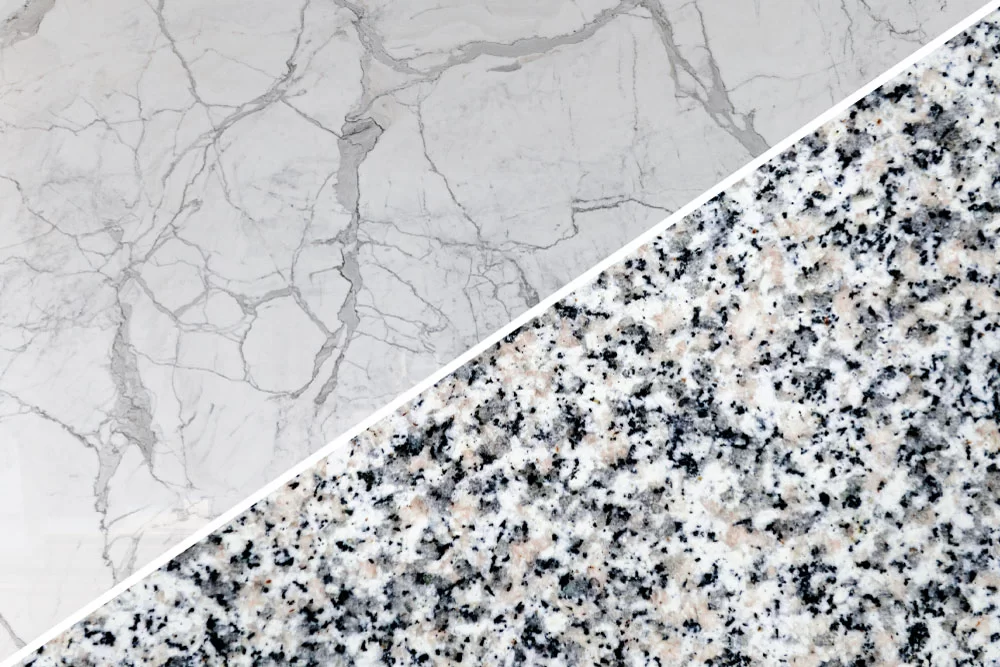
How to tell Granite from Marble?
Distinguishing between granite and marble can be challenging for someone without prior knowledge, but there are a few key visual and tactile cues to consider. Granite often displays a speckled or mottled appearance with a granular texture, while marble tends to have more uniform coloring with veins or streaks running through it and a smoother texture. Additionally, granite is generally harder and less porous than marble, making it more resistant to scratches and staining. Observing these characteristics, such as color, texture, and veining, can help in making an educated guess about whether a stone surface is granite or marble.
Granite vs. Marble – Hardness, Porosity, and Staining Compared
In this comparison, we delve into the key differences between these two natural stones, focusing on their hardness, porosity, and susceptibility to staining. Understanding these factors can help you make an informed decision when selecting the perfect material for your project.
Marble vs. Granite Hardness
Marble and granite are widely used natural stones, each known for its unique characteristics. One key aspect where they differ significantly is hardness.
Granite Hardness: Granite is renowned for its durability and hardness. Composed mainly of quartz, feldspar, and mica, granite ranks high on the Mohs scale of mineral hardness, typically ranging from 6 to 7. This makes it exceptionally resistant to scratches and chips, making it a preferred choice for high-traffic areas like kitchen countertops.
Marble Hardness: Marble, on the other hand, is softer compared to granite. Its primary mineral, calcite, ranks lower on the Mohs scale, usually between 3 and 5. While marble offers an elegant and timeless appearance, its softer nature makes it more susceptible to scratching and etching, particularly when exposed to acidic substances.
READ | What Is The Hardness Of Granite? Understanding Granite Hardness on the Mohs Scale

Marble vs. Granite Porosity
Stains on Granite vs. Marble
Uses of Granite vs Marble
In the clash between granite and marble, these stones often find themselves in direct competition, especially in applications where their unique properties are put to the test. Let’s explore some major battlegrounds where granite and marble face off directly
Difference Between Granite and Marble Flooring
-
Granite Flooring:
- High-Traffic Areas: Granite flooring is highly durable and resistant to wear and tear, making it an excellent choice for high-traffic areas such as kitchens, hallways, and entryways. Its hardness and scratch resistance ensure that it can withstand the daily rigors of foot traffic without showing signs of wear.
- Commercial Spaces: Due to its durability and low-maintenance nature, granite flooring is often used in commercial settings such as restaurants, hotels, and retail stores. It can withstand heavy foot traffic and is resistant to stains and moisture, making it ideal for areas with frequent use.
- Outdoor Spaces: Granite flooring is also suitable for outdoor applications such as patios, pool decks, and pathways. Its resistance to weathering and durability make it a practical choice for areas exposed to the elements.
-
Marble Flooring:
- Aesthetic Spaces: Marble flooring is prized for its luxurious appearance and elegant aesthetic, making it a preferred choice for formal living rooms, dining areas, and bedrooms.
- Light-Traffic Areas: While marble is less durable than granite and more susceptible to scratching, etching, and staining, it is still suitable for areas with lighter foot traffic such as master bedrooms, home offices, and sitting rooms. In these spaces, the emphasis is often on aesthetics rather than durability.
- Decorative Accents: Marble flooring is frequently used as a decorative accent in homes and commercial spaces, such as inlay designs, borders, and medallions. Its beauty and versatility allow for creative expression and customization in interior design.

Marble vs Granite Countertops
Marble Countertops:
Pros:
- Luxurious Appearance: Marble countertops offer a timeless, elegant aesthetic with unique veining patterns and a range of colors.
- Heat Resistance: Marble is naturally cool and heat resistant, making it ideal for baking and pastry preparation.
- Installation and workability: Marble is relatively easy to shape and cut, allowing for custom designs and intricate detailing.
Cons:
- Porous Nature: Marble is more prone to staining and etching from acidic substances like citrus juices and wine.
- Scratches Easily: Marble is softer and more susceptible to scratching compared to granite, requiring more careful maintenance.
- Limited Color Options: While marble comes in various colors and patterns, the selection is generally more limited compared to granite.
- Higher Cost: Marble countertops tend to be more expensive than granite due to their rarity and the labor-intensive process of extraction and fabrication.
Granite Countertops:
Pros:
- Durability: Granite is highly durable and resistant to scratches, heat, and stains, making it ideal for high-traffic kitchens.
- Wide Range of Colors: Granite countertops come in a wide array of colors and patterns, from subtle neutrals to bold hues.
- Low Maintenance: Granite countertops are relatively low maintenance and easy to clean with mild soap and water.
Cons:
- Limited Workability: Granite is harder and more challenging to shape and cut compared to marble, limiting design flexibility.
- Cold Surface: Granite can feel cold to the touch, which may be uncomfortable for some, especially in colder climates.
- Susceptible to Cracking: While highly durable, granite countertops can still crack if subjected to extreme force or pressure.
Granite Or Marble For Stairs
Choosing between granite and marble for stairs depends on factors such as durability, aesthetics, and budget. Here’s a breakdown to help you decide:
Granite for Stairs:
Pros:
- Durability: Granite is highly durable and resistant to wear and tear, making it suitable for high-traffic areas like stairs.
- Scratch Resistance: Granite is less susceptible to scratches compared to marble, maintaining its appearance over time.
- Wide Range of Colors: Granite comes in various colors and patterns, allowing for customization to match the overall design scheme.
- Low Maintenance: Granite stairs are relatively low maintenance and easy to clean with mild soap and water.
Cons:
- Limited Workability: Granite is harder to shape and cut compared to marble, limiting design flexibility for intricate stair designs.
Marble for Stairs:
Pros:
- Luxurious Appearance: Marble stairs exude elegance and sophistication with their unique veining patterns and range of colors.
- Heat Resistance: Marble remains cool to the touch, making it comfortable for barefoot use on stairs.
- Aesthetic Versatility: Marble offers versatility in design, allowing for custom detailing and intricate patterns on stair treads.
Cons:
- Susceptibility to Wear: Marble is softer and more prone to scratching and etching compared to granite, requiring more frequent maintenance to preserve its appearance.
- Porous Nature: Marble is more porous and susceptible to staining from spills and moisture, especially in high-traffic areas like stairs.
- Higher Cost: Marble stairs are typically more expensive than granite due to the material’s rarity and the labor-intensive process of extraction and fabrication.
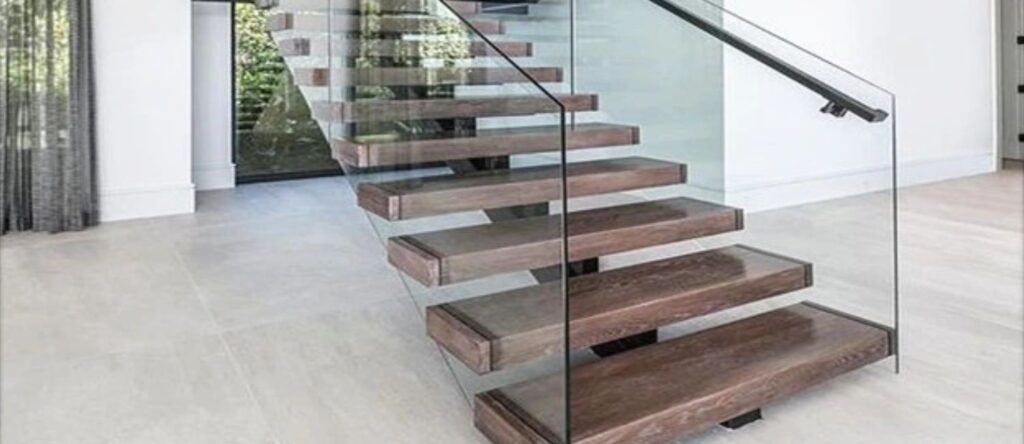
Granite Vs. Marble Installation
Granite Installation:
- Durability: Granite is known for its hardness and durability, making it easier to handle during installation without the risk of breakage or damage.
- Standard Installation Techniques: Granite installation typically follows standard practices, with fewer complexities compared to marble.
- Weight: Granite is heavy, which may require additional structural support during installation, especially for large countertops or vertical applications.
- Limited Workability: While durable, granite can be more challenging to shape and cut compared to marble, potentially increasing labor costs.
Marble Installation:
- Aesthetic Flexibility: Marble’s softness and workability allow for intricate detailing and custom designs during installation, making it suitable for unique projects.
- Luxurious Appearance: Marble’s unique veining patterns and range of colors add a touch of luxury and sophistication to any space.
- Susceptibility to Damage: Marble is softer and more prone to scratching, chipping, and etching during installation, requiring careful handling to avoid damage.
- Porous Nature: Marble is more porous than granite, making it susceptible to staining from spills and moisture during installation, which may require additional sealing and maintenance.
Granite And Marble Polish
Comparing granite and marble polish involves considering factors such as shine, durability, maintenance, and suitability for various applications. Here’s a comparison of granite and marble polish:
Granite Polish:
- Shine: Granite polish typically results in a glossy finish that enhances the natural beauty of the stone, giving it a luxurious appearance.
- Durability: Granite polish is highly durable and resistant to wear and tear, maintaining its shine even in high-traffic areas like kitchen countertops.
- Low Maintenance: Once polished, granite requires minimal maintenance to preserve its shine, typically requiring only periodic cleaning with mild soap and water.
- Suitability for Outdoor Use: Granite polish is suitable for outdoor applications such as patio countertops or pool surrounds, where durability and resistance to weathering are essential.
Marble Polish:
- Shine: Marble polish results in a high-gloss finish that highlights the stone’s unique veining patterns and colors, giving it a sophisticated and elegant appearance.
- Durability: While marble polish provides a stunning shine, marble itself is softer and more susceptible to scratching, etching, and dulling compared to granite, requiring more delicate maintenance to preserve its polish.
- Maintenance: Marble requires more frequent polishing and sealing to maintain its shine and protect against stains and etching from acidic substances like citrus juices and wine.
- Indoor Use: Marble polish is best suited for indoor applications such as flooring, countertops, and decorative accents, where it can be protected from harsh environmental factors.
Both granite and marble offer a range of finish options to suit different preferences and applications, granite tends to have more textured finishes such as leathered or flamed, while marble offers finishes that highlight its unique veining patterns and colors, such as polished or honed.

Granite vs Marble Health Benefits
Let’s explore different perspectives on the health benefits of granite and marble:
Granite Vs. Marble From a Hygiene Perspective:
-
Granite:
- Offers a hygienic surface due to its low porosity when properly sealed, making it resistant to bacterial growth and easy to clean.
- Suitable for food preparation areas where maintaining cleanliness is essential, contributing to better hygiene and food safety.
-
Marble:
- While marble is also non-porous when properly sealed, it may require more frequent maintenance to prevent staining and bacterial growth due to its higher porosity compared to granite.
- However, marble’s cool surface can provide comfort and relief, particularly in warmer climates, contributing to a comfortable and healthy living environment.
Marble Vs. Granite From an Environmental Perspective:
-
Granite:
- Being a natural stone, granite is a sustainable and eco-friendly choice for countertops and surfaces, contributing to environmentally responsible construction practices.
- Its durability and longevity reduce the need for frequent replacement, minimizing waste and resource consumption over time.
-
Marble:
- Marble is also a natural material sourced from quarries, contributing to sustainable construction practices.
- However, the process of extracting and fabricating marble may involve more energy and resources compared to granite due to its softer composition, potentially impacting the environment to a greater extent.
Differance between Granite and Marble from Comfort Perspective:
-
Granite:
- Provides a stable and supportive surface for various activities, including barefoot walking, cooking, and food preparation.
- Its resistance to becoming slippery when wet enhances safety and comfort, particularly in areas prone to moisture.
-
Marble:
- Offers a cool and refreshing sensation underfoot, making it a preferred choice for areas where comfort and relaxation are prioritized, such as bathrooms and spa environments.
- However, its tendency to become slippery when wet may pose safety concerns, requiring caution and proper maintenance to ensure a safe and comfortable environment.
READ | Is Granite Food Safe? Exploring the Health Risk of Granite in Countertops and Cookware
Maintenance of Granite & Marble
-
- Marble requires regular sealing to protect against stains and etching. Spills should be wiped up immediately, and acidic or abrasive cleaners should be avoided.
- Granite is less porous and generally requires less maintenance than marble. While sealing is still recommended to enhance its stain resistance, granite is more forgiving of spills and less prone to etching.
The price difference between marble and granite can vary depending on factors such as quality, rarity, origin, and market demand. However, some general differences can be noted:
Marble Price:
- Price Range: Marble is generally considered more expensive than granite, with prices typically ranging from moderate to high.
- Factors Influencing Price: The cost of marble can vary based on factors such as the type of marble (e.g., Carrara, Calacatta), rarity of the color or veining pattern, quality of the stone (e.g., grade A, commercial grade), and thickness of the slab.
- Installation Costs: Additionally, installation costs for marble may be higher due to its softer nature, which requires more delicate handling and specialized equipment.
Granite Price:
- Price Range: Granite tends to be more affordable compared to marble, with prices ranging from moderate to high depending on the quality, rarity, and origin of the stone.
- Factors Influencing Price: The cost of granite can vary based on factors such as the colour, pattern, and origin of the stone (e.g., rare granite may command higher prices), as well as the thickness and finish of the slab.
- Installation Costs: Installation costs for granite may be lower compared to marble, as granite is harder and more durable, requiring less specialized equipment and labor for handling and installation.
READ | Granite Price Per Square Foot – Understanding Factors
Which One is Better: Marble or Granite
Ultimately, the choice between marble and granite depends on individual preferences, budget, and intended use. If you prioritize aesthetics and are willing to invest in maintenance, marble may be the better option for creating a luxurious and timeless space. However, if durability, versatility, and practicality are paramount, granite may be the preferred choice for its resilience and suitability for a wide range of applications. Consulting with a design professional can also help you determine the best option based on your project requirements and preferences.
Frequently Asked Questions on Granite Vs. Marble
Which is Stronger Granite or Marble?
Granite is renowned for its exceptional strength and durability, making it one of the toughest natural stones available for various applications. Unlike marble, which is softer and more prone to scratching and chipping, granite is highly resistant to wear and tear, making it ideal for high-traffic areas such as kitchen countertops, flooring, and commercial spaces.
Is Granite Porous?
Granite is generally less porous than marble but can still absorb liquids if left unsealed. Sealing granite helps reduce its porosity, making it more resistant to staining and easier to clean.
Is Marble Porous?
Yes, marble is porous. It has a higher porosity compared to granite, which means it can absorb liquids more readily if left unsealed.
Is Marble More Porous than Granite?
Yes, marble is generally more porous than granite. This means it has a higher tendency to absorb liquids and stains if left unsealed.
Is Granite Stronger than Marble?
Granite typically exhibits greater strength and durability compared to marble. Comprising quartz, feldspar, and other minerals, granite boasts high resistance against scratches, chipping, and damage caused by heat and chemicals. In contrast, marble, with its softer composition, tends to be more prone to scratching, chipping, and staining.
What Are The Differences In Hardness Between Marble And Granite?
When comparing hardness between marble and granite, granite generally ranks higher on the Mohs scale of mineral hardness. Granite typically falls between 6 to 7 on the scale, whereas marble typically ranges between 3 to 5. This difference in hardness means that granite is more resistant to scratching, chipping, and other forms of damage compared to marble.
Is Marble More Expensive Than Granite?
Yes, generally marble is more expensive. However, cheaper options are available in marble. Despite this, additional and higher costs such as installation and on-site polishing can contribute to making marble the more expensive option overall.

